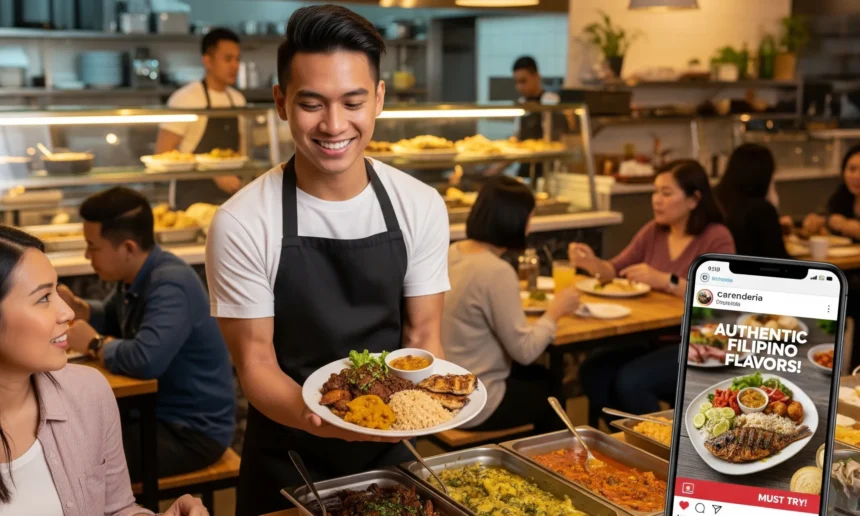💔 The Heart of the Kitchen: Why Every Pinoy Dreams of a Food Business
There’s a special kind of magic in the Filipino kitchen. It’s where flavors tell stories, where recipes are passed down through generations, and where every meal is an act of love. This deep, almost sacred connection to food makes the idea of starting a food business incredibly alluring for many Filipinos. You’ve probably thought about it, my friend, haven’t you? Turning your lola’s (grandmother’s) secret adobo recipe into a hit, or transforming your passion for baking into a thriving enterprise. The dream is simple: share your delicious creations, make people happy, and earn a living doing what you love. It feels like a natural fit.
- 💔 The Heart of the Kitchen: Why Every Pinoy Dreams of a Food Business
- 🍽️ The Allure of the Kitchen: Why Food is Always a Hot Business
- 📈 Riding the Wave: Food Trends That Actually Work
- 📉 The Pitfalls: Common Mistakes That Can Kill Your Dream
- 📢 Beyond the Plate: Marketing That Sells Your Food
- 💰 The Numbers Game: Budgeting and ROI Expectations
- ✨ Top 5 Food Concepts That Are Thriving in the Philippines
- 🚫 5 Mistakes That Will Kill Your Food Business
- 🤔 FAQs about Starting a Small Food Business
- The Final Ingredient: Innovate, Adapt, and Hustle
- 🧭 References
The food business in the Philippines seems to have a low barrier to entry. You can start small, perhaps selling homemade kakanin (rice cakes) from your tahanan (home) or setting up a humble food stall in a bazaar. This accessibility, combined with our inherent love for food and our entrepreneurial spirit, makes the food industry a constant magnet for aspiring negosyantes (business owners). But beneath the delicious aroma and the promise of quick returns lies a brutally competitive landscape. The journey from a passionate cook to a successful food entrepreneur is fraught with challenges, hidden costs, and common pitfalls that can quickly turn a sweet dream into a bitter reality. This guide will be your honest mentor, revealing what truly works and what doesn’t, so you can navigate the exciting, yet challenging, world of starting a small food business in the Philippines.
🍽️ The Allure of the Kitchen: Why Food is Always a Hot Business
The Philippines boasts a vibrant, almost obsessive, food culture. Food is central to every celebration, every gathering, and every expression of hospitality. This deep cultural connection is a primary reason why the food business remains perpetually popular among Filipinos. We don’t just eat to live; we live to eat, to share, and to celebrate through food. This inherent love creates a massive, consistent market for culinary creations, from traditional comfort food to innovative new dishes.
Moreover, the food business often appears to have a relatively low entry barrier compared to other industries. You don’t necessarily need a massive capital investment or a specialized degree to start. Many successful food entrepreneurs began by selling homemade goods from their kitchens, leveraging existing skills and minimal resources. This accessibility encourages aspiring negosyantes to take the plunge, believing that passion and good recipes are enough to succeed. The entrepreneurial spirit of Filipinos, coupled with our natural inclination towards hospitality and sharing food, makes the food industry a default choice for many seeking to start their own venture. However, this very accessibility also means intense competition, making it crucial to understand the dynamics beyond just cooking delicious food.
📈 Riding the Wave: Food Trends That Actually Work
The Philippine food scene is constantly evolving, driven by changing consumer preferences, technological advancements, and a vibrant entrepreneurial spirit. To succeed, aspiring food business owners must not only create delicious food but also understand and leverage the trends that are shaping the market. These trends offer unique opportunities for growth and differentiation.
🍔 Food Parks: The Communal Feast Experience
Food parks exploded in popularity over the past decade, transforming vacant lots into vibrant, open-air dining destinations. They offer a diverse array of food concepts in a casual, communal setting, appealing to young professionals and families alike. For aspiring entrepreneurs, food parks provide a relatively lower-cost entry point than a full-fledged restaurant. You typically rent a stall, reducing overheads like extensive renovations and long-term leases. The shared marketing efforts of the food park management also help drive foot traffic. The atmosphere is often lively, with live music and themed events, creating a unique dining experience. However, competition within a food park can be fierce, and success often hinges on having a unique concept that stands out amidst dozens of other stalls. The initial investment for a stall can range from ₱50,000 to ₱200,000, covering equipment and initial inventory.
☁️ Cloud Kitchens: The Digital Dining Revolution
Cloud kitchens, also known as ghost kitchens or dark kitchens, are a relatively new but rapidly growing trend, especially accelerated by the pandemic. These are commercial kitchens that operate solely for delivery, with no dine-in area or storefront. They cater exclusively to online orders placed through food delivery apps like GrabFood and Foodpanda. This model significantly reduces overhead costs associated with rent, front-of-house staff, and interior design. It allows entrepreneurs to focus purely on food preparation and efficiency. Cloud kitchens are ideal for those with a strong online presence and a menu optimized for delivery. They offer immense flexibility, allowing businesses to test multiple concepts from a single kitchen or expand into new areas without heavy investment. However, success in this space heavily relies on strong digital marketing, efficient logistics, and a deep understanding of food delivery platforms.
🍜 Niche Cuisine and Specialty Foods: Standing Out from the Crowd
In a saturated market, having a unique selling proposition (USP) is paramount. Niche cuisine and specialty foods allow you to carve out a specific market segment, appealing to customers looking for something different from the usual. This could be anything from artisanal ube (purple yam) desserts, gourmet longganisa (sausage), vegan Filipino dishes, or even specific regional delicacies from a province like Isabela that are hard to find in the city. The key is to identify an underserved market or a unique culinary gap. This strategy allows you to command higher prices and build a loyal customer base that specifically seeks out your unique offerings. Marketing becomes easier when you have a clear identity and a compelling story behind your food. The challenge lies in consistently delivering high-quality, authentic, and unique products that justify their premium.
📉 The Pitfalls: Common Mistakes That Can Kill Your Dream
The path to food business success is littered with good intentions and delicious recipes that ultimately failed. Understanding the common mistakes that derail aspiring entrepreneurs is crucial for avoiding them and protecting your investment. Being brutally honest about these pitfalls can save you a lot of heartache and pera.
📍 Poor Location or Visibility (Even Online)
Even for home-based or cloud kitchen businesses, location and visibility matter. For physical stalls or restaurants, a bad location with low foot traffic or poor accessibility is a death sentence. For online businesses, a lack of strong digital presence means your delicious food remains a secret. You can cook the best sinigang (sour soup) in the world, but if no one knows about it, you won’t sell a single bowl. Many entrepreneurs underestimate the importance of market research and visibility, assuming that good food will automatically attract customers. This is a fatal flaw.
🤷 Lack of a Unique Selling Proposition (USP)
In a market overflowing with food choices, simply selling “good food” isn’t enough. What makes your adobo different from the thousands of others? Why should a customer choose your halo-halo (mixed dessert) over the one across the street? Without a clear USP-whether it’s a unique flavor profile, a special ingredient, a compelling brand story, or exceptional service-your business will struggle to stand out. Many entrepreneurs fall into the trap of offering generic menus, failing to give customers a compelling reason to choose them. This leads to intense price competition and a struggle for market share.
💸 Underestimating Costs and Overestimating Profits
This is perhaps the most common and devastating mistake. Aspiring entrepreneurs often focus only on the obvious costs like ingredients and basic equipment, completely overlooking hidden expenses. These include permits and licenses, utility bills (electricity, water, gas), packaging, delivery fees, marketing expenses, unexpected repairs, and even your own labor. Many also overestimate their potential sales and profit margins, leading to unrealistic financial projections. This lack of financial foresight can quickly deplete your capital, leaving you unable to sustain operations before you even break even. It’s a brutal reality check for many.
😠 Poor Customer Service and Inconsistent Quality
In the Philippines, customer service is king. Filipinos value warmth, friendliness, and a personal touch. A rude staff member, a delayed order, or a perceived lack of care can quickly turn a customer away, often leading to negative word-of-mouth or online reviews. Similarly, inconsistent quality is a death knell. If your sisig (sizzling pork dish) is delicious one day but bland the next, customers will lose trust. They expect consistency. Many small businesses, overwhelmed by growth, struggle to maintain quality control as they scale, leading to a decline in customer satisfaction and loyalty. The balik-balik (return customer) factor is crucial in the food business, and inconsistent quality quickly erodes it.
🚫 Ignoring Permits and Legalities
Many small-scale food businesses, especially home-based ones, start without proper permits and licenses. While this might seem convenient initially, it can lead to severe problems down the line, including fines, forced closures, and a lack of credibility. Operating legally ensures food safety standards are met, protects your business, and allows for future expansion. Ignoring these crucial steps is a short-sighted mistake that can have long-term consequences.
📢 Beyond the Plate: Marketing That Sells Your Food
Having delicious food is only half the battle; the other half is letting people know about it. In today’s digital age, effective marketing is as crucial as a great recipe. It’s about creating a buzz, building a brand, and connecting with your target audience.
📱 Social Media: Your Digital Menu and Storyteller
Social media platforms like Facebook, Instagram, and TikTok are your most powerful marketing tools, especially for small food businesses. They allow you to showcase your food visually, share your unique story, and engage directly with your customers.
- High-Quality Photos and Videos: Food is visual. Invest time in taking appealing photos and short videos of your dishes. Use good lighting and simple plating.
- Engaging Content: Don’t just post pictures of food. Share behind-the-scenes glimpses, cooking tips, customer testimonials, and even your personal journey. Tell your story.
- Run Contests and Giveaways: These can quickly boost engagement and attract new followers.
- Use Relevant Hashtags: Increase discoverability by using a mix of broad and specific hashtags (e.g., #FilipinoFood #HomemadePH #SupportLocal).
- Respond to Comments and Messages: Engage with your audience. Show them you care.
🤝 Influencer Partnerships: The Power of Recommendation
Micro-influencers and food bloggers can be powerful allies for small food businesses. They have dedicated followers who trust their recommendations. Collaborating with them can give your business a significant boost in visibility and credibility. Look for influencers whose audience aligns with your target market. Offer them free food in exchange for an honest review or a sponsored post. The power of word-of-mouth, amplified by an influencer, is immense.
🎪 Community Events and Bazaars: Taste and Connect
Participating in local community events, bazaars, and food fairs offers a fantastic opportunity to directly connect with potential customers. It allows people to taste your food, experience your brand, and meet you in person. This direct interaction can build trust and loyalty. It’s also a great way to get immediate feedback on your products and test new menu items. The atmosphere of these events is often festive, providing a perfect backdrop for your food.
🗣️ Word-of-Mouth: The Original Viral Marketing
In the Philippines, chismis (gossip) is a powerful force. If your food is delicious and your service is excellent, people will talk about it. They will recommend you to their friends and family. This organic word-of-mouth marketing is the most powerful and cost-effective form of promotion. Focus on consistently delivering exceptional food and customer service, and your customers will become your most effective marketers.
💰 The Numbers Game: Budgeting and ROI Expectations
Starting a food business, no matter how small, requires careful financial planning. Underestimating costs is a common pitfall, so having a clear budget and realistic expectations for your return on investment (ROI) is crucial.
Food Business Startup Cost Breakdown (Estimated)
These figures are approximate and can vary wildly depending on location (Metro Manila vs. province), scale, and whether you use existing equipment.
Note: These ranges are broad estimates. Actual costs can vary significantly.
Average ROI Timelines by Type of Food Business
Return on Investment (ROI) is crucial for assessing profitability. This table provides general, approximate timelines for when different types of food businesses might start seeing a return on their initial investment and become profitable.
Note: These timelines are highly dependent on factors like sales volume, cost management, marketing effectiveness, and unexpected expenses. They are general guides, not guarantees.
✨ Top 5 Food Concepts That Are Thriving in the Philippines
- Silog Meals and All-Day Breakfast: Filipinos love their silog (rice with egg and a main dish like tapa, longganisa, or tocino). This comfort food staple thrives because it’s versatile, affordable, and appeals to all ages, making it perfect for quick meals or delivery.
- Lutong Bahay (Home-Cooked Meals) Delivery: With busy schedules, many crave authentic, home-cooked Filipino dishes but lack the time to prepare them. Offering daily lutong bahay meals for delivery caters to office workers and families, providing convenience and a taste of home.
- Specialty Coffee and Milk Tea: The coffee and milk tea craze shows no signs of slowing down. Niche coffee shops offering unique blends or aesthetically pleasing milk tea concoctions attract a loyal following, especially among young urbanites.
- Artisanal Desserts and Baked Goods: From customized cakes and gourmet cookies to unique Filipino desserts with a modern twist (e.g., ube cheesecakes, pandan pastries), there’s a strong market for high-quality, visually appealing sweet treats, often driven by social media.
- Street Food with a Twist: Elevating popular Filipino street food (like isaw, kwek-kwek, fishball) with a gourmet touch, unique sauces, or a cleaner, more appealing presentation can attract a wider customer base, blending familiarity with innovation.
🚫 5 Mistakes That Will Kill Your Food Business
- No Clear Concept or Niche: Trying to be everything to everyone leads to mediocrity. Without a unique identity, your food gets lost in the sea of competition.
- Ignoring Financial Planning: Operating without a detailed budget, underestimating costs, and failing to track expenses will quickly lead to cash flow problems and eventual bankruptcy.
- Poor Quality Control: Inconsistent taste, portion sizes, or presentation will quickly erode customer trust and loyalty. Customers expect the same delicious experience every time.
- Neglecting Customer Service: Rude staff, slow service, or a dismissive attitude towards feedback will drive customers away, regardless of how good your food is. Filipinos value hospitality.
- Lack of Effective Marketing: Even the best food won’t sell itself. Without a strong marketing strategy, especially online, your target customers won’t know you exist, leading to low sales and stagnant growth.
🤔 FAQs about Starting a Small Food Business
Q1: Do you need a permit for home-based food selling in the Philippines? A: Yes, ideally. While many start informally, it’s highly recommended to secure necessary permits and licenses (like DTI registration, Barangay Clearance, Mayor’s Permit, and DOH/FDA for food safety) to operate legally, build trust, and avoid future issues.
Q2: How do you price your food effectively? A: Pricing involves calculating your total costs (ingredients, labor, overheads) per serving, then adding a profit margin. Research competitor prices, consider your unique selling proposition, and understand what your target market is willing to pay. Don’t just copy others’ prices.
Q3: What are the biggest challenges for home-based food businesses? A: Challenges include managing time between home and business, separating personal and business finances, limited production capacity, marketing without a physical storefront, and navigating legal requirements for home-based operations.
Q4: Is it better to start with a physical store or an online-only model? A: It depends on your budget and concept. Online-only (cloud kitchen/delivery) has lower startup costs and wider reach. A physical store offers direct customer interaction and brand visibility but requires higher investment and overheads.
Q5: How important is food safety for a small food business? A: Food safety is paramount. It protects your customers’ health and your business’s reputation. Adhere to proper hygiene, storage, and preparation practices. Consider getting basic food handling certifications.
Q6: Can I get a loan to start a small food business? A: Yes, various financing options exist, including microloans from government agencies (like DTI, DOST), cooperatives, or even personal loans. Prepare a solid business plan to present to lenders.
Q7: How can I make my food business stand out in a crowded market? A: Focus on a unique selling proposition (USP), whether it’s a signature dish, a unique flavor profile, a compelling brand story, exceptional customer service, or a niche market. Consistent quality and strong marketing are also key.
Q8: What are the key legal requirements for a food business in the Philippines? A: Key requirements typically include DTI registration (for sole proprietorship), Barangay Clearance, Mayor’s Permit, BIR registration, and for food businesses, a Sanitary Permit from the local health office and potentially FDA registration.
Q9: How do I manage inventory and food waste? A: Implement a system for tracking inventory, forecasting demand, and practicing proper food storage. Minimize waste by optimizing portion sizes, repurposing ingredients, and managing your supply chain efficiently.
Q10: What kind of marketing budget should I allocate for a small food business? A: Even with a small budget, allocate funds for online marketing (social media ads, boosting posts), good photography, and potentially collaborations with micro-influencers. Start with free organic marketing efforts first.
The Final Ingredient: Innovate, Adapt, and Hustle
Starting a small food business in the Philippines is more than just cooking; it’s a journey of passion, perseverance, and relentless learning. The path is challenging, filled with common mistakes that can quickly derail even the most delicious dreams. But by understanding the market trends, avoiding common pitfalls, mastering effective marketing, and planning your finances meticulously, you can significantly increase your chances of success.
The Filipino entrepreneurial spirit, fueled by our unwavering love for food, is a powerful force. So, if you have that secret recipe, that unique concept, or that burning desire to share your culinary creations, don’t hesitate. Innovate. Adapt. And most importantly, hustle. The market is hungry, my friend, and your delicious dream might just be the next big thing. Go get that negosyo!
🧭 References
-
Madiskarte Moms PH – Start a home-based food business PH (2025)
-
Shopify PH – Food business ideas & tips for 2025
-
Unilever Food Solutions – Start a food business with small capital
-
Triple i Consulting – Permits needed for a food business










